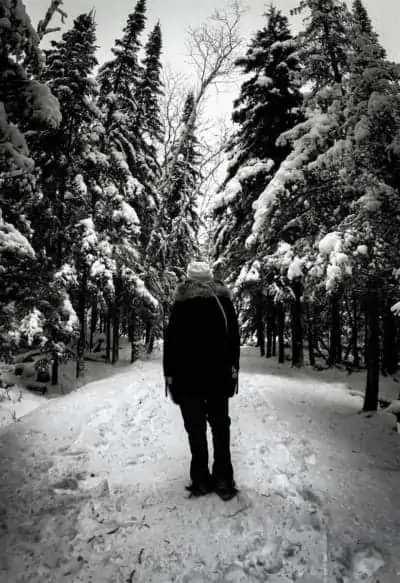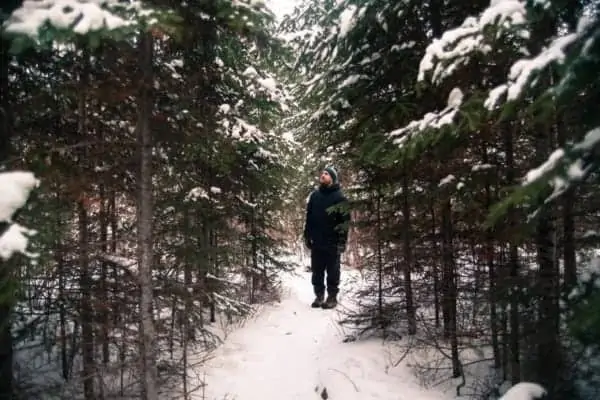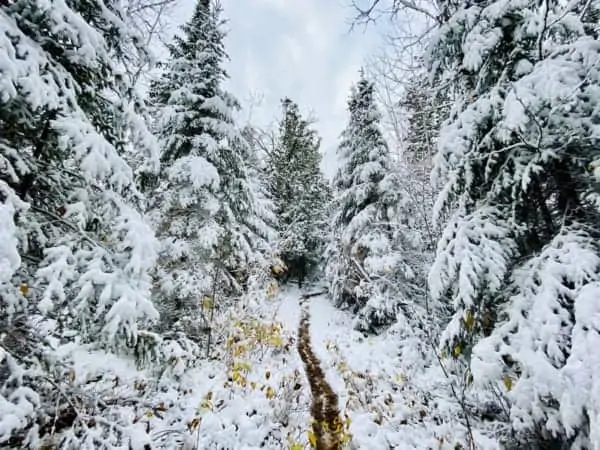Winter recreation such as skiing, snowshoeing, snowmobiling, and much more can be enjoyed on the North Shore all winter long. Another one of the winter activity that gets overlooked is winter hiking. The state parks literally clear out after MEA weekend and don’t spring back alive until after the thaw around Memorial Day.
 This is one of the main reasons we recommend you try a winter hike, at least once, during your next visit to the North Shore. Hopefully, by the end of this article you will be excited, inspired, and prepared to get out and adventure on one of the many great trails here on the North Shore.
This is one of the main reasons we recommend you try a winter hike, at least once, during your next visit to the North Shore. Hopefully, by the end of this article you will be excited, inspired, and prepared to get out and adventure on one of the many great trails here on the North Shore.
Tips for Winter Hiking
Dodging the Crowds
With park attendance reaching over 7,000 people per day at Gooseberry Falls the state parks on the North Shore can get very crowded in the summer season. Personally, fighting over parking spots and waiting in line at overlooks isn’t my idea of connecting with nature and enjoying the natural beauty of Minnesota. This is the main reason I enjoy hiking in the wintertime. To put this in perspective when I last visited Tettegouche State Park there was a total of one car and two White Tail Deer greeting me in the parking lot when I pulled in. A much different experience than say… 4th of July weekend.
Having the trails to yourself is nothing short of a magical experience. When you can hike for miles without seeing another human you truly feel one with nature and all of your senses are heightened. I challenge you to take a break on one of your next hikes and sit in silence for 10 or 15 minutes. Submerge yourself in the simplicity of that moment in nature. This is an experience one will never regret.
Another benefit of having the trail to yourself is enjoying one of the many overlooks. Nothing is worse than feeling guilty for being in the way, or limiting to your time at a certain spot just because there are other people waiting to snap a photo or take in the view. Hike in the winter and you can spend hours staring up at that waterfall if you choose to.
Fresh Snow
There is nothing better than getting out for a hike right after a new snowfall. The beauty and aesthetics of the sun’s reflection illuminating off the snow has a magical way of lighting the forest. The fresh blanket of snow covering the foliage gives you a warm feeling that is truly comforting. These types of conditions make for great photos and an overall great experience for any hiker.
 Another advantage of the fresh snowfall is finding and following animal tracks. Tracking and sighting wildlife can be quite challenging but having a set of tracks to follow will give you better odds of finding something, and also allows your mind to run wild with an imagination of what animal it might be. Seeing all of these tracks scattered across the blanket of snow seems to make the forest come alive as you can see every movement from the night before.
Another advantage of the fresh snowfall is finding and following animal tracks. Tracking and sighting wildlife can be quite challenging but having a set of tracks to follow will give you better odds of finding something, and also allows your mind to run wild with an imagination of what animal it might be. Seeing all of these tracks scattered across the blanket of snow seems to make the forest come alive as you can see every movement from the night before.
On some of my recent hikes, I have found rabbit, deer, fox & wolf tracks. Rabbit and deer tracks are easily identified, but distinguishing fox, coyote, wolf, or cougar tracks can be quite difficult. Here is a great article to help you identify them more easily.
Weather Conditions
Although the majority of people in the United States think that Minnesotans are borderline crazy dealing with the cold winter conditions, if you were raised in Minnesota you know that it really isn’t that bad! When the temperatures can literally fluctuate 50+ degrees practically overnight your body learns to adapt.
Recent winters have not been much different from winters past. You can have temps that dip to -50 all the way up to 45 above zero on those unseasonably warm days. For the most part, the area stays between 0 and 32 degrees. We don’t recommend going out when it gets too cold, but those days are usually few and far between.
Dressing the Part
There’s a popular saying up here that there is no bad weather- just bad clothing. If you dress correctly you can enjoy outdoor wintertime adventures safely.
When dressing for a winter hike there are a few things to consider.
“Cotton Kills”. This another popular, local phrase that is to remind you to avoid materials that absorb moisture. Being cold is one problem but being cold and wet is a quick way to put yourself in danger. Generally, you want to dress in 3 main layers. Your base layer should be moisture-wicking, some type of synthetic or “Under Armour” material. This way if you sweat it can easily dry itself.
 Your second layer needs to be your insulator; wool and fleece being your best options. If you are prone to getting cold, this where you layer up until you can hardly move your arms and you look like the younger brother in “A Christmas Story”. Your final outer layer needs to be waterproof, something that can protect you from the elements whether it’s snow, rain, or that Minnesota mix that is something in between. Don’t forget a hat and gloves!
Your second layer needs to be your insulator; wool and fleece being your best options. If you are prone to getting cold, this where you layer up until you can hardly move your arms and you look like the younger brother in “A Christmas Story”. Your final outer layer needs to be waterproof, something that can protect you from the elements whether it’s snow, rain, or that Minnesota mix that is something in between. Don’t forget a hat and gloves!
Another thing to remember is the fact that you can always take layers off. Most people will overdress and soon get overheated as you enter the mid-stages of your hike. It is very important to not get overheated while on the trail. If you begin to sweat out your base layer this is going to make you wet and cold later on. Be sure to remove layers as you begin to warm up.
Packing the Right Equipment
Preparing a small backpack with the right supplies can greatly improve your experience and keep you safe from the elements. Here is a list of items I like to bring, especially on longer hikes when you are out of cell service.
- Water
- High protein snacks
- A warm beverage (nothing more enjoyable in the cold woods)
- Hand warmers
- A dry pair of gloves and socks (these areas are most prone to frostbite)
- Small first aid kit
- A camera
- A lighter or matches for emergency situations
Another bonus to carrying a backpack with you on your winter hike is having a place to store your outer layers, should you find yourself removing those. It never hurts to be over-prepared and ensuring a happy and healthy hike is worth the effort. So enough about the preparation, where is a good spot to hike?
Where to Hike
 Split Rock
Split Rock
Split Rock Lighthouse and State Park is just southeast of Beaver Bay on the lakeside of highway 61. This hike offers easy hiking and fantastic views of the lighthouse. It is a great place to view the waves of Lake Superior crashing against the rock walls that suspend the lighthouse over the lake. This sensation really gives you a perspective of why the lighthouse is there, and the cold & rough conditions the giant ships of the great lakes face every winter season.
Illgen Falls
Located just off Highway 61 a few miles up Highway 1 is Illgen Falls on the Baptism River. The hike is a short ¼ mile off of the road and you end up right on top of a 40-foot waterfall. This is a nice short hike with great views and is one of the destinations that frequently gets overlooked.
Cascade Falls
Cascade State Park is located between Lutsen and Grand Marais on Highway 61. The parking lot just off of the road will lead you to the trailhead. A short hike up and you will begin to see one of many great waterfalls. These trails are frequently used and make for an easy hike with literally multiple waterfalls in a row. This is also a great area to stop and view the lake right from the parking lot.
Pincushion Mountain Overlook
Once you get into the town of Grand Marais turn onto 5th Ave, as if you are heading to the hospital. Drive past the hospital and turn left onto the Gunflint Trail. A short drive up the Trail you’ll see a sign for the Pincushion Mountain Overlook. From the parking lot you are greeted with incredible views of downtown Grand Marais, the Grand Marais Harbor, and Lake Superior. Head towards the back of the parking lot to find the Pincushion Mountain Trail System. This 9-mile out and back trail system is great for a quick hike or long adventure.
 Honeymoon Bluff
Honeymoon Bluff
If you have a vehicle with 4-wheel drive or are visiting the North Shore days/weeks after the move recent snowfall and want to have a more off-the-beaten-path adventure, head further up the Gunflint Trail and take a right onto Clearwater Road (county road 66, look for the sign for Clearwater Lodge). About two miles down Clearwater Road you will see signs for Honeymoon Bluff on the left side of the road. This trail is only a 0.4-mile loop but offers incredible views of Hungry Jack Lake. The Gunflint Trail area also tends to have more snow earlier in the winter, so if it’s still “gray season” down by the lake, head inland.
Now that you have some ideas of where to hike, what to bring, and some motive to why hiking in the winter is great, I hope you take the opportunity to get out there and adventure. There is nobody that can create a great experience better than yourself. I challenge you to make it happen and I hope this article will help you along the way.
